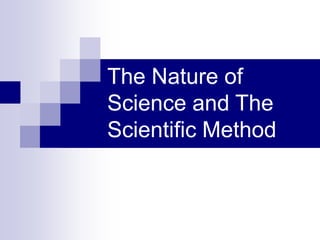
1. Scientific Method.ppt
- 1. The Nature of Science and The Scientific Method
- 2. What is Science SCIENCE IS….. a way in which answers related to NATURAL events are proposed a way in which people can learn and UNDERSTAND events in the NATURAL WORLD. based on OBSERVABLE EVENTS a study of the NATURAL WORLD a method of DISCOVERY and UNDERSTANDING by using a PROBLEM SOLVING process called the????
- 3. 6 Steps to the Scientific Method 1. Make an observation 2. Form a hypothesis 3. Test the hypothesis 4. Collect, Organize and Analyze the Data 5. Draw Conclusions 6. Communicate the results
- 4. Step 1: Observations Observations based on senses or tools Sight, Smell, Touch etc. Observations of natural events usually raise a question Why did the water rise when the candle went out? Research is usually done to help find out more about the question raised
- 5. Step 2: Form A Hypothesis Based on your observation a Hypothesis is formed that tries to explain your observation or answer your question A hypothesis tries to predict or determine the outcome of your experiment even before the experiment is done Predictions usually stated in an “if ….. Then” statement. Ex: If I drop a rock then it will fall down toward the ground HYPOTHESIS MUST BE TESTABLE!
- 6. Step 3: Test the Hypothesis Controlled Experiments are used to test a hypothesis A controlled experiment is an experiment that tests only one factor at a time by a control group is compared with an experimental group. Variables are not changed in the Control Group. Control groups allows you to see if a change in a variable creates an observed outcome by comparing the control group with the exp gp A variable is a factor that changes in a controlled experiment. Variables are changed in the Exp Group AND SERVE AS THE FACTOR TESTED
- 7. VARIABLES INDEPENDENT The variable being changed in the experiment DEPENDENT The variable that responds to the changed independent variable The variable being measured EX: growing plants with different amounts of fertilizer
- 8. Step 3 Continued Scientists try to design experiments that will clearly show whether a particular VARIABLE caused an observed outcome IF IT CANNOT BE OBSERVED THEN IT CANNOT BE TESTED!!! Can we test if a comet impact kill the dinosaurs? Why or Why Not? Sometimes models are used to represent a real object Used when it is difficult to control all of the variables or not possible to test “the real thing”
- 9. Variables are not Changed in C.G. One Variable Changed in Each Exp. Group
- 10. Step 4: Collect, Organize & Analyze Data Data collected from experiments Data is defined as: recorded observations or measurements (qualitative = description, quantitative = number data) Based on observations Utilize tools or senses: sight, smell, temperature change etc. Data is organized in tables, charts and graphs so that it can be more easily analyzed
- 11. Step 5: Draw Conclusions Scientists decide whether the results of the experiment support a hypothesis. When the hypothesis is not supported by the tests the scientist must find another explanation for what they have observed NO EXPERIMENT IS A FAILURE: All experiments are observations of real events
- 12. Step 6: Communicate the Results Results must be communicated in the form of a written paper or presentation Communication helps other scientists performing the same experiments to see if the results of your experiment are the same as their results Helps people see if results are repeatable!
- 13. Theories Theories are explanations for some phenomena based on observation, experimentation, and reasoning. BASED ON MANY EXPERIMENTS Experiments that explain a theory MUST be repeatable You must be able to predict from a theory
- 14. LAWS Laws are summaries of many experimental results and observations Laws are not the same as theories because laws tell only what happens, not why it happens.
- 15. Pure Science PURE SCIENCE Pure Science: An attempt to learn more about the world or the continuing search for scientific knowledge. pure science is done by scientists or people with inquisitive minds involves experimentation, observations, questioning and research involves technology
- 16. Technology Technology: An application of science to meet the needs of society engineers, inventors and creative people apply scientific knowledge to build new “things” or tools new technology can lead to new scientific discoveries ex: we could not learn about cells before the invention of the microscope Question: How does science lead to new technology and how does technology add to our scientific understanding of the natural world?